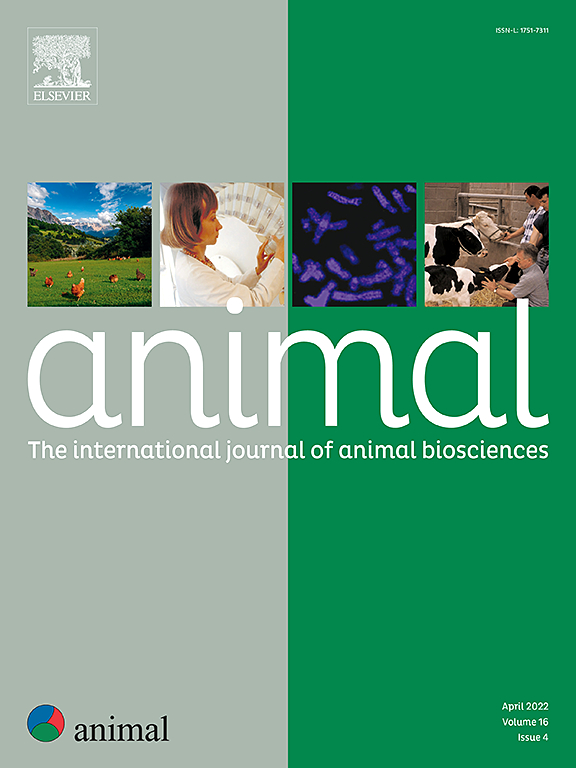初产和多产奶牛在整个泌乳期饲喂不同浓度日粮蛋白质的饲料和能量利用效率
IF 4
2区 农林科学
Q1 AGRICULTURE, DAIRY & ANIMAL SCIENCE
引用次数: 0
摘要
降低饲粮粗蛋白质浓度可以降低奶牛饲养成本和氮排泄,但可能对生产率和效率产生负面影响。本试验研究了初产和多产奶牛泌乳早期、中期和后期饲粮CP浓度降低对生产能力、饲料和能量利用效率以及CH4排放参数的影响。选取24头荷斯泰因-弗里西亚奶牛(12头初产、12头多产),分别饲喂CP含量为12.2、15.1和18.1% (LCP、MCP和HCP)的3种试验总混合口粮;在哺乳期(第1-305天)的连续研究中。在哺乳早期、中期和晚期,在代谢单元和间接开路呼吸量热计室测量消化率和气体交换。采用重复测量的线性混合模型分析数据,以CP浓度、泌乳期、胎次及其相互作用为固定效应,拟合奶牛为被试和泌乳期的随机效应为重复测量。与LCP处理相比,MCP和HCP处理的DM采食量(DMI)分别为+1.9和+3.0 kg/d,产奶量(+5.5和+7.7 kg/d),能量修正产奶量(ECMY)分别为+5.0和+7.1 kg/d,饲料效率(ECMY/DMI)分别为+0.13和+0.15 kg/kg;乳固体/DMI, +16和+20 g/kg;乳能量输出(EL)/DMI, +0.40和0.46 MJ/kg)。消化能采食量(DEI)/总能采食量(GEI)、代谢能采食量(MEI)/GEI、MEI/DEI和经零能量平衡调整的乳能输出(EL(0))/MEI均高于LCP(+0.02、+0.03、+0.02和+0.06 MJ/MJ),而DEI/GEI在LCP和MCP之间无差异,MEI/DEI和EL(0)/MEI在MCP和HCP之间无差异。与LCP相比,MCP(- 3.2和- 3.1 g/kg)和HCP(- 3.8和- 3.4 g/kg)的每可消化DMI和ECMY的甲烷产量较低。MCP(- 0.007、- 0.011和- 0.014 MJ/MJ)和HCP(- 0.007、- 0.014和- 0.017 MJ/MJ)的GEI、DEI和MEI甲烷能均低于LCP。CP浓度和泌乳阶段对产奶量和ECMY的显著交互作用表明,随着泌乳的进行,处理差异(MCP或HCP饲粮与LCP饲粮的增加值)减小。饲粮中添加15.1%粗蛋白质(DM)可能足以维持产奶量和饲料效率,同时降低CH4产量和强度。然而,回归分析表明,产蛋率在15% ~ 18%粗蛋白质(DM)之间可能会进一步提高,但对饲粮粗蛋白质的反应可能取决于泌乳期。本文章由计算机程序翻译,如有差异,请以英文原文为准。
Efficiency of feed and energy use in primiparous and multiparous dairy cows fed contrasting dietary protein concentrations across lactation
Reducing dietary CP concentration can reduce feeding costs and N excretion in dairy production but may negatively impact productivity and efficiency. This study investigated the impact of reduced dietary CP concentration, across early, mid− and late−lactation stages in primiparous and multiparous lactating cows, on productivity, feed and energy use efficiency and CH4 emission parameters. Twenty-four Holstein-Friesian (12 primiparous, 12 multiparous) cows were allocated to three experimental total mixed rations containing 12.2, 15.1 or 18.1% CP (LCP, MCP and HCP, respectively; DM basis), in a continuous study across lactation (days 1–305). Digestibility and gas exchanges were measured in metabolism units and indirect open-circuit respiration calorimeter chambers during early, mid− and late−lactation. Data were analysed using a linear mixed model, with repeated measures, with CP concentration, stage of lactation, parity and their interactions as fixed effects, and a random effect of cow fitted as the subject and stage of lactation as the repeated measure. When compared with LCP treatment, MCP and HCP had higher DM intake (DMI) (+1.9 and +3.0 kg/d), milk yield (+5.5 and +7.7 kg/d), energy corrected milk yield (ECMY) (+5.0 and +7.1 kg/d), and feed efficiency (ECMY/DMI, +0.13 and +0.15 kg/kg; milk solids/DMI, +16 and +20 g/kg; milk energy output (EL)/DMI, +0.40 and 0.46 MJ/kg). Digestible energy intake (DEI)/gross energy intake (GEI), metabolisable energy intake (MEI)/GEI, MEI/DEI and milk energy output adjusted for zero energy balance (EL(0))/MEI were higher in HCP (+0.02, +0.03, +0.02, and +0.06 MJ/MJ) than LCP while there were no differences between LCP and MCP for DEI/GEI, or between MCP and HCP for MEI/DEI and EL(0)/MEI. Methane production per digestible DMI and ECMY were lower for MCP (−3.2 and −3.1 g/kg) and HCP (−3.8 and −3.4 g/kg), when compared with LCP. Methane energy per GEI, DEI and MEI were lower for the MCP (−0.007, −0.011 and −0.014 MJ/MJ) and HCP (−0.007, −0.014 and −0.017 MJ/MJ) than LCP. The significant interaction between CP concentration and stage of lactation on milk yield and ECMY showed that treatment differences (increased values in MCP or HCP vs LCP diets) reduced as lactation progressed. A diet containing 15.1% CP (DM basis) may be sufficient to maintain milk production and feed efficiency while reducing CH4 yield and intensity. However, regression analysis suggests that productivity may increase further between 15 and 18% CP (DM basis) but the response to dietary CP may depend on the stage of lactation.
求助全文
通过发布文献求助,成功后即可免费获取论文全文。
去求助
来源期刊

Animal
农林科学-奶制品与动物科学
CiteScore
7.50
自引率
2.80%
发文量
246
审稿时长
3 months
期刊介绍:
Editorial board
animal attracts the best research in animal biology and animal systems from across the spectrum of the agricultural, biomedical, and environmental sciences. It is the central element in an exciting collaboration between the British Society of Animal Science (BSAS), Institut National de la Recherche Agronomique (INRA) and the European Federation of Animal Science (EAAP) and represents a merging of three scientific journals: Animal Science; Animal Research; Reproduction, Nutrition, Development. animal publishes original cutting-edge research, ''hot'' topics and horizon-scanning reviews on animal-related aspects of the life sciences at the molecular, cellular, organ, whole animal and production system levels. The main subject areas include: breeding and genetics; nutrition; physiology and functional biology of systems; behaviour, health and welfare; farming systems, environmental impact and climate change; product quality, human health and well-being. Animal models and papers dealing with the integration of research between these topics and their impact on the environment and people are particularly welcome.
 求助内容:
求助内容: 应助结果提醒方式:
应助结果提醒方式:


